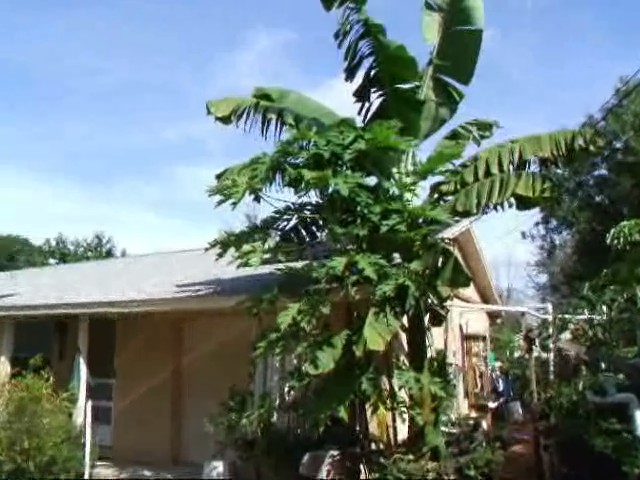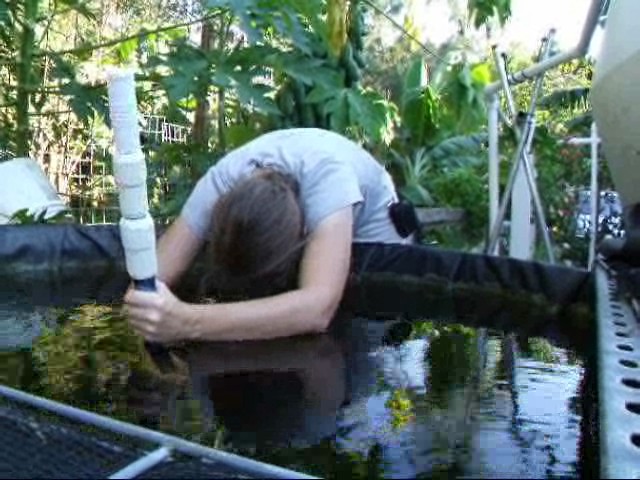Originally posted by TCLynx on AGC, June 18, 2010
Now I feel a little out of order here since I realize that I probably haven’t done a very good job of describing my main system or any of my other systems on this site. (The main system’s story is a bit long and I don’t quite feel up to re-writing that whole story at the moment.)
But anyway….. Now with a couple years experience keeping fish (I really didn’t know much about keeping fish before I got into this) and nursing the bio-filters and coaxing the plants, I’m feeling a bit more confident in my system design skills (though I’m sure they are not perfect.)
Enter TCLynx’s 300 gallon system. Totally separate from the main system. Even bought new gravel to avoid all the shells mixed into my original system gravel.
Here is the location for the new system with the 300 gallon fish tank already sunk in the ground
This will be a combo system
Three 100 gallon Rubbermaid stock tanks as gravel grow beds doing flood and drain in sequence via an Aquaponics Indexing valve.
The hard part here is really actually leveling the blocks for under the stock tanks. It doesn’t seem like it should be such a hard task but I fear I personally rank it as less desirable a task than gravel washing. See the blocks need to be stable and level or the stock tank won’t sit level and if the blocks don’t provide good support to the tank, it is possible that there could be problems in the future. So pack the sub surface and put some effort into making sure there isn’t a lot of organic mater under the blocks that would rot away and reduce the stability of the foundation so to speak. Once I had the tanks in place, I filled them with water to help compress the surface under the blocks and make sure things wouldn’t be sinking right away.
I will add Zipgrow towers to round out the filtration to give me the ability to stock this system to the max.
The system foundation is a 300 gallon Rubbermaid stock tank sunk into my sand about 2/3rds of the way.
I have just spent the past 3 days washing the gravel. I tell you this is not the weather for that activity (each morning I started progressively earlier to avoid the heat as best I could.) I did limit myself to filling only one bed per day since I was doing it alone and with the heat, I didn’t want to kill myself.
Was hot so I needed to set up shade for the gravel washing station. Make sure to set up your gravel washing station ergonomically so you are not
bending while swishing.
I use two bins of water when washing my gravel. I swish a plant basket have full of gravel in the first bin then let the dirty water drain out
of the basket then I swish in the cleaner water. Eventually the dirty
water gets dumped and the cleaner water becomes the dirty water and the
empty bin gets re-filled with clean water.
Use small buckets for toting rock and you get hurt less.
Adding gravel into the bed, keep the stand pipe guard properly positioned.
This is the gravel level just below the high water level, I will now pull out the stand pipe to let the water drain and allow me to add the
greensand supplement.
Then I drill a couple holes in the stand pipe so the bed will be able to drain when I put it back in.
right below the high water level when the grow beds flood, I sprinkled about a quart of greensand which is a potassium and iron supplement.
This bed is almost full but the gravel will settle over the next several days and will need to be topped up.
And here is what I think is “the really cleaver bit”
This is a filter pad I had sitting under a constant inlet to a grow bed. The worms just love filter material, especially when full of worm poo
and other debris.
The filter material full of worms from the other system now placed under the water inlet to the grow bed. Seems like an easy way to get the worm
goodies into the new system.
That concludes the picture part of the story for today, for those who are interested in details read on.
For now the pumping is being done by a single Quiet One 4000 pump which is on a timer and feeding the indexing valve. (I fear I may be riding the lower limit of what kind of pump it takes to operate even the Aquponic Indexing valve.) When I add the towers, I will feed them with a second Quiet One 4000 which will run constantly and provide aeration in addition to the flow for the towers. This system might not get an air pump. I might simply set up a battery backup that would run the pump feeding the towers which would provide aeration and filtration in the event of a power failure.
Building this system is a very different experience compared to building the main system. The main system grew and changed and grew and changed. I don’t really expect this one to change nearly as much. I’ve already learned many tricks with plumbing and layout that I didn’t know two years ago. I’ve also learned other lessons, like what happens with wood and liner in a wet sub tropical environment (Termites.) I’ve learned about sizing drains and making sure you can pull and flip the stand pipes to hold a bed flooded when that is needed or to simply enlarge or cover holes in a stand pipe to adjust flows. If the part with the holes is not movable……. well the drill won’t fit down the gravel guard to adjust things. Also, the 100 gallon stock tanks seem to sit quite nicely on 5 concrete blocks and that puts them at a nice height. Once I get enough mulch down so the pipes are not trip hazards, the beds will be at about hip height to me.
Also, after testing out the Zipgrow towers on the front porch, I now know how I will need to set up the plumbing for them (and what size/how many holes I need to put in the caps to feed them the correct amount of water from this pump.)
So as soon as I filled the first grow bed I added a dose of well aged hummonia which brought the ammonia level up to 1.5 ppm. Two days later the ammonia was down to .25 ppm (some of that due to using the system water to wash gravel and then topping up with fresh water.) And the nitrite was up to .25 so it has started. Will let the numbers drop to 0 now that I have adjusted the pH and have all three beds cycling. Once ammonia and nitrite are 0 I’ll probably give it a big dose of hummonia and let the numbers drop to 0 again. At that point, I might add fish and finish the process with fish or I might continue the fishless cycle up (will all depend on how sorry I feel for the little fish all crammed together in the current quarantine system who don’t get enough to eat cause the system can’t handle anymore.)





Leave a Reply